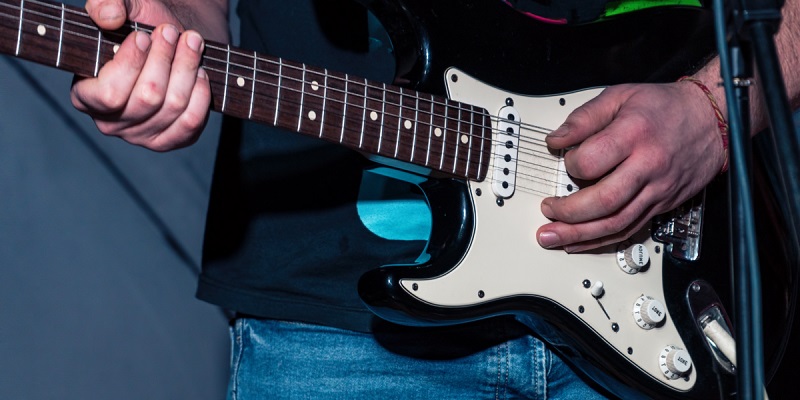Are you a left-handed guitarist on the hunt for your first guitar? Getting your first guitar might seem overwhelming, but don’t worry – with the right guidance and knowledge, you’ll be able to choose the perfect one for you. Here’s what you need to know about a left handed electric guitar and how it’s built.
What’s a Left-Handed Guitar?

A left-handed guitar is a flipped version of a regular guitar. Everything, from the strings to the angle of the saddle, is reversed. This allows left-handed guitarists to strum with their dominant hand and finger chords with their right hand. Since the dominant hand is usually more coordinated, playing with the left hand can result in smoother and more fluid music.
However, left-handed guitars aren’t as widely available as right-handed ones. That’s why many lefties choose to start learning on a right-handed guitar as beginners, simply because there are more options to choose from.
Before you decide on whether to buy your first left handed electric guitar, it’s a good idea to understand the differences between the two. You can even go to a guitar store and try out both left-handed and right-handed guitars to see which style feels more natural to you.
Left-Handed vs. Right-Handed Guitars
The guitar may appear symmetrical, leading some to believe that lefties can simply flip a right-handed guitar to make it more comfortable. However, converting a right-handed guitar into a left-handed one is not as straightforward as it seems.
The Strings
The most significant distinction lies in the arrangement of the strings. In a left-handed guitar, the bass strings should be positioned at the top, with the treble notes below them. However, if you were to flip a right-handed guitar to the left side, the bass notes would end up at the bottom. To transform a right-handed guitar into a left-handed one, you would need to re-string the instrument from top to bottom.
The Pickguard
Many acoustic and electric guitars feature pickguards, which rest beneath the soundhole. These pickguards protect the instrument from scratches caused by enthusiastic strumming. However, if you were to play a right-handed guitar upside down, the pickguard would be positioned above the hole. Not only is this position impractical, but it also looks visually incorrect. When you purchase a left-handed guitar, the pickguard is correctly placed below the soundhole.
The Saddle
The guitar’s saddle angle can also indicate whether it is meant for left-handed or right-handed players. It’s important to note that the saddle is slightly slanted to ensure proper intonation. For a left-handed acoustic guitar, the saddle needs to slant in the opposite direction. This slant ensures that the low E string is the longest, while the treble strings are shorter.
Strap Peg
On a right-handed guitar, the strap peg is located above the guitar neck. However, if you flip it to the left side, the strap peg will be under the fretboard. This would make it quite awkward to play with a strap! But when you purchase a left-handed guitar, the strap peg is positioned above the fretboard, allowing you to attach a guitar strap without any interference from the strings.
Body Shape
Many guitars feature a single or double cutaway design. This ergonomic design makes it easier for your fingers to reach the strings on the upper frets. With a left-handed guitar, you can strum with your dominant hand, putting you on an equal footing with right-handed guitarists.
What to Consider When Buying

When you’re getting your first left-handed guitar, there are a few things you should keep in mind. First off, figure out your budget and what kind of guitar you want. Are you leaning towards acoustic or electric? Are you a beginner or a pro? Once you’ve got that sorted, here are a few more things to consider:
- Playability – check if the guitar feels comfortable to play and if the strings are at the right height.
- Quality – look for a guitar that’s well-made with good materials.
- Sound – listen closely to the guitar’s sound and make sure it’s the kind of sound you’re after.
- Accessories – be sure the guitar comes with all the necessary extras like a case, strap, and tuner.
Benefits of Playing a Left-Handed Guitar
Playing a left-handed guitar has its own set of advantages that can enhance your musical abilities and expand your playing horizons. Here are a few benefits to consider:
- Enhanced Agility – by playing a left-handed guitar, you can develop greater agility in your fretting hand. This can lead to improved speed and accuracy in your playing.
- Refined Technique – opting for a left-handed guitar can help you refine your technique, as it requires you to use your fretting hand uniquely compared to a right-handed guitar.
- Unleashed creativity – playing a left-handed guitar can unlock a world of new musical ideas and possibilities, allowing you to explore uncharted territories in your playing style.
- Enhanced Comfort – for some players, a left-handed guitar offers a higher level of comfort as it enables them to utilize their dominant hand for fretting, resulting in a more natural playing experience.

Leave a comment